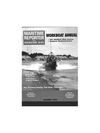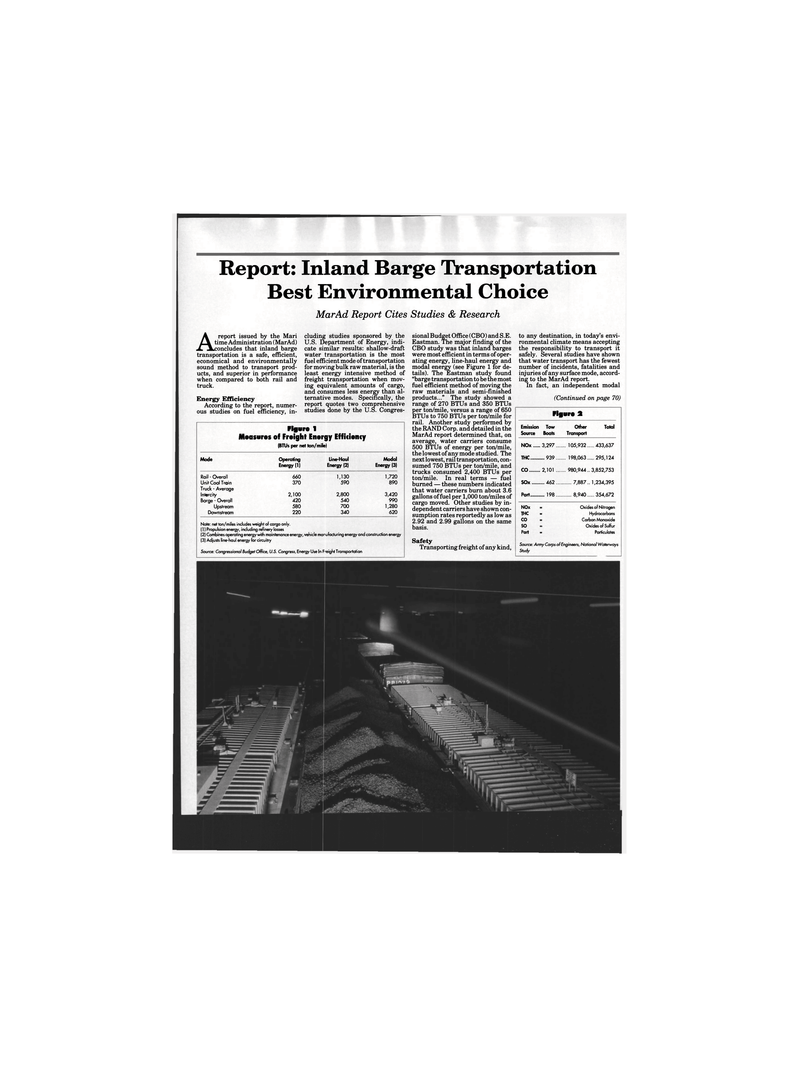
Page 81: of Maritime Reporter Magazine (October 1994)
Read this page in Pdf, Flash or Html5 edition of October 1994 Maritime Reporter Magazine
Report: Inland Barge Transportation
Best Environmental Choice
MarAd Report Cites Studies & Research
A report issued by the Mari time Administration (MarAd) concludes that inland barge transportation is a safe, efficient, economical and environmentally sound method to transport prod- ucts, and superior in performance when compared to both rail and truck.
Energy Efficiency
According to the report, numer- ous studies on fuel efficiency, in- cluding studies sponsored by the
U.S. Department of Energy, indi- cate similar results: shallow-draft water transportation is the most fuel efficient mode of transportation for moving bulk raw material, is the least energy intensive method of freight transportation when mov- ing equivalent amounts of cargo, and consumes less energy than al- ternative modes. Specifically, the report quotes two comprehensive studies done by the U.S. Congres-
Figure 1
Measures of freight Energy Efficiency (BTUs per net ton/mile)
Mode Operating Line-Haul Modal
Energy (1) Energy (2) Energy (3)
Rail - Overall 660 1,130 1,720
Unit Coal Train 370 590 890
Truck - Average
Intercity 2,100 2,800 3,420
Barge - Overall 420 540 990
Upstream 580 700 1,280
Downstream 220 340 620
Note: net ton/miles includes weight of cargo only. (1) Propulsion energy, including refinery losses (2) Combines operating energy with maintenance energy, vehicle manufacturing energy and construction energy (3) Adjusts line-haul energy for circuitry
Source: Congressional Budget Office, U.S. Congress, Energy Use In Freight Transportation sional Budget Office (CBO) and S.E.
Eastman. The major finding of the
CBO study was that inland barges were most efficient in terms of oper- ating energy, line-haul energy and modal energy (see Figure 1 for de- tails). The Eastman study found "barge transportation to be the most fuel efficient method of moving the raw materials and semi-finished products..." The study showed a range of 270 BTUs and 350 BTUs per ton/mile, versus a range of 650
BTUs to 750 BTUs per ton/mile for rail. Another study performed by the RAND Corp. and detailed in the
MarAd report determined that, on average, water carriers consume 500 BTUs of energy per ton/mile, the lowest of any mode studied. The next lowest, rail transportation, con- sumed 750 BTUs per ton/mile, and trucks consumed 2,400 BTUs per ton/mile. In real terms — fuel burned — these numbers indicated that water carriers burn about 3.6 gallons of fuel per 1,000 ton/miles of cargo moved. Other studies by in- dependent carriers have shown con- sumption rates reportedly as low as 2.92 and 2.99 gallons on the same basis.
Safety
Transporting freight of any kind, to any destination, in today's envi- ronmental climate means accepting the responsibility to transport it safely. Several studies have shown that water transport has the fewest number of incidents, fatalities and injuries of any surface mode, accord- ing to the MarAd report.
In fact, an independent modal (Continued on page 70)
Figure 2
Emission Tow Other Total
Source Boats Transport
NOx 3,297 105,932 433,637
THC 939 198,063 295,124
CO 2,101 980,944.. 3,852,753
SOx 462 7,887.. 1,234,395
Part 198 8,940 354,672
NOx = Oxides of Nitrogen
THC = Hydrocarbons
CO = Carbon Monoxide
SO - Oxides of Sulfur
Part = Particulates
Source: Army Corps of Engineers, National Waterways
Study

 80
80

 82
82
